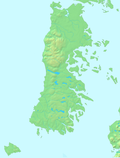Chilote school of religious imagery
 Procession Christ, Church of Caguach (18th century). Articulated Sculpture from chilota School of imagery. | |
| Localization | Chiloé Archipelago, |
|---|---|
| Artistic manifestation | Colonial Hispano-American Art |
| Style | Religious art |
| Historic period | 16th century - 19th century |
| Number of exponents | At least 456 pieces[1] |
| Material | Polychrome wood as a typical element. |
Chilote School of Religious Imagery —Spanish: Escuela chilota de Imaginería Religiosa—, is an artistic and cultural manifestation that was developed during the 17th century on the basis of the circular movement of evangelizing established by the Jesuit missionaries, and reaches its climax in the late 19th century.[2][3]
Its character of "school" lies in that these sculptures shape a "type" that altered the typical archetypal of American and Spanish Baroque imagery; as a product of cultural syncretism and miscegenation, the works of this school was developed locally and are characterized by the combination and adaptation of European, Latin American and Indigenous features.[4] This artistic expression differs from peninsular, quiteña or cuzqueña artistic production: it can appreciate remarkable differences in technique, materials and style.[2][5]
References
- ^ Vásquez de Acuña, Isidoro (1994). Santería de Chiloé: Ensayo y Catastro (in Spanish). Santiago de Chile: Editorial Antártica. p. 175. ISBN 978-95-6234-025-0.
- ^ a b Vázquez de Acuña, Isidoro (1956). Costumbres religiosas de Chiloé y su raigambre hispana (PDF). Santiago: Centro de Estudios Antropológicos. p. 107.
- ^ Consejo de Monumentos Nacionales (2003). Postulación de las iglesias de Chiloé para su inclusión en la lista del patrimonio mundial ante la UNESCO (in Spanish). Santiago de Chile: Consejo de Monumentos Nacionales. ISBN 956-7953-00-7.
- ^ Barruel, Esteban (1997). Los fiscales de Chiloé: una ruta devocional (in Spanish). Santiago de Chile: Ediciones Orígenes. p. 267.
- ^ Hanisch Espíndola, Walter (1982). La Isla de Chiloé, capitana de rutas australes (in Spanish). Santiago de Chile: Academia Superior de Ciencias Pedagógicas de Santiago. p. 266.

